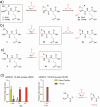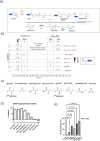Aldehyde-mediated inhibition of asparagine biosynthesis has implications for diabetes and alcoholism
- PMID: 38362406
- PMCID: PMC10866355
- DOI: 10.1039/d3sc06551k
Aldehyde-mediated inhibition of asparagine biosynthesis has implications for diabetes and alcoholism
Abstract
Patients with alcoholism and type 2 diabetes manifest altered metabolism, including elevated aldehyde levels and unusually low asparagine levels. We show that asparagine synthetase B (ASNS), the only human asparagine-forming enzyme, is inhibited by disease-relevant reactive aldehydes, including formaldehyde and acetaldehyde. Cellular studies show non-cytotoxic amounts of reactive aldehydes induce a decrease in asparagine levels. Biochemical analyses reveal inhibition results from reaction of the aldehydes with the catalytically important N-terminal cysteine of ASNS. The combined cellular and biochemical results suggest a possible mechanism underlying the low asparagine levels in alcoholism and diabetes. The results will stimulate research on the biological consequences of the reactions of aldehydes with nucleophilic residues.
This journal is © The Royal Society of Chemistry.
Conflict of interest statement
There are no conflicts to declare.
Figures



Similar articles
-
Targeting Asparagine Synthetase in Tumorgenicity Using Patient-Derived Tumor-Initiating Cells.Cells. 2022 Oct 18;11(20):3273. doi: 10.3390/cells11203273. Cells. 2022. PMID: 36291140 Free PMC article.
-
Biology of disease. Alcoholism and aldehydism: new biomedical concepts.Lab Invest. 1984 Jan;50(1):5-15. Lab Invest. 1984. PMID: 6363815
-
Asparagine Synthetase-Mediated l-Asparagine Metabolism Disorder Promotes the Perineural Invasion of Oral Squamous Cell Carcinoma.Front Oncol. 2021 Mar 10;11:637226. doi: 10.3389/fonc.2021.637226. eCollection 2021. Front Oncol. 2021. PMID: 33777794 Free PMC article.
-
Asparagine synthetase: regulation by cell stress and involvement in tumor biology.Am J Physiol Endocrinol Metab. 2013 Apr 15;304(8):E789-99. doi: 10.1152/ajpendo.00015.2013. Epub 2013 Feb 12. Am J Physiol Endocrinol Metab. 2013. PMID: 23403946 Free PMC article. Review.
-
The role of asparagine synthetase on nutrient metabolism in pancreatic disease.Pancreatology. 2020 Sep;20(6):1029-1034. doi: 10.1016/j.pan.2020.08.002. Epub 2020 Aug 8. Pancreatology. 2020. PMID: 32800652 Review.
Cited by
-
Formaldehyde quantification using gas chromatography-mass spectrometry reveals high background environmental formaldehyde levels.Sci Rep. 2024 Sep 4;14(1):20621. doi: 10.1038/s41598-024-71271-z. Sci Rep. 2024. PMID: 39232096 Free PMC article.
-
Effects of alcohol on the transcriptome, methylome and metabolome of in vitro gastrulating human embryonic cells.Dis Model Mech. 2025 Jun 1;18(6):dmm052150. doi: 10.1242/dmm.052150. Epub 2025 Jun 18. Dis Model Mech. 2025. PMID: 40401629 Free PMC article.
References
Grants and funding
LinkOut - more resources
Full Text Sources

